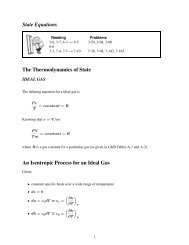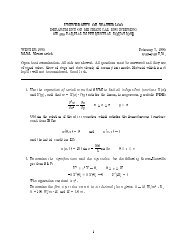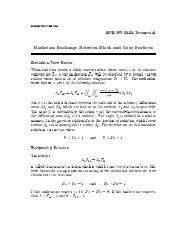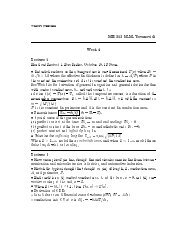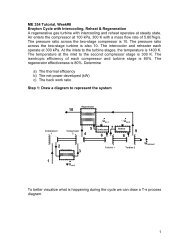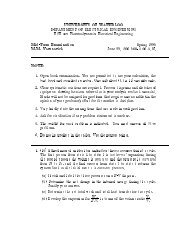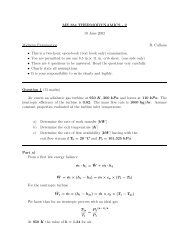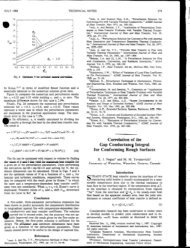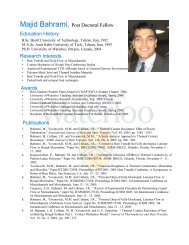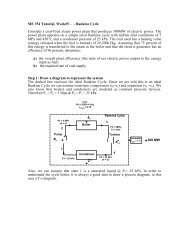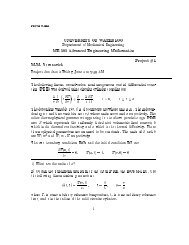Rankine Cycle Definitions
Rankine Cycle Definitions
Rankine Cycle Definitions
Create successful ePaper yourself
Turn your PDF publications into a flip-book with our unique Google optimized e-Paper software.
<strong>Rankine</strong> <strong>Cycle</strong>Reading Problems10-2 → 10-7 10-16, 10-34, 10-37, 10-44, 10-47, 10-59<strong>Definitions</strong>• working fluid is alternately vaporized and condensed as it recirculates in a closed cycle• water is typically used as the working fluid because of its low cost and relatively large valueof enthalpy of vaporization• the standard vapour cycle that excludes internal irreversibilities is called the Ideal <strong>Rankine</strong><strong>Cycle</strong>• the condensation process is allowed to proceed to completion betweenstate points 4 → 1– provides a saturated liquid at 1• the water at state point 1 can be conveniently pumped to the boiler pressure at state point 2• but the water is not at the saturation temperature corresponding to the boiler pressure• heat must be added to change the water at 2 to saturated water at ‘a’• when heat is added at non-constant temperature (between 2 − a), the cycle efficiency willdecrease1
Analyze the ProcessAssume steady flow, KE = PE =0.From a 1st law balance, we knowenergy in = energy outDevice1st Law BalanceBoiler h 2 + q H = h 3 ⇒ q H = h 3 − h 2 (in)Turbine h 3 = h 4 + w T ⇒ w T = h 3 − h 4 (out)Condenser h 4 = h 1 + q L ⇒ q L = h 4 − h 1 (out)Pump h 1 + w P = h 2 ⇒ w P = h 2 − h 1 (in)The net work output is given asw T − w p = (h 3 − h 4 ) − (h 2 − h 1 )= (h 3 − h 4 )+(h 1 − h 2 )The net heat supplied to the boiler isq H =(h 3 − h 2 )The <strong>Rankine</strong> efficiency isη R =net work outputheat supplied to the boiler= (h 3 − h 4 )+(h 1 − h 2 )(h 3 − h 2 )2
If we consider the fluid to be incompressible(h 2 − h 1 )=v(P 2 − P 1 )Since the actual process is irreversible, an isentropic efficiency can be defined such thatExpansion process ⇒ Isentropic efficiency =actual workisentropic workisentropic workCompression process ⇒ Isentropic efficiency =actual workBoth isentropic efficiencies will have a numerical value between 0 and 1.Effects of Boiler and Condenser PressureWe know the efficiency is proportional toη ∝ 1 − T LT HThe question is → how do we increase efficiency ⇒ T L ↓ and/or T H ↑.1. INCREASED BOILER PRESSURE:• an increase in boiler pressure results in a higher T H for the same T L , therefore η ↑.• but 4 ′ has a lower quality than 4– wetter steam at the turbine exhaust3
2. LOWER T L :– results in cavitation of the turbine blades– η ↓ plus ↑ maintenance• quality should be > 80% at the turbine exhaust• we are generally limited by the TER(lake, river, etc.)eg. lake @ 15 ◦ C +ΔT } =10 {{ ◦ C}=25 ◦ Cresistance to HT⇒ P sat =3.2 kP a.• this is why we have a condenser– the pressure at the exit of the turbine can be less than atmospheric pressure– the closed loop of the condenser allows us to use treated water on the cycle side– but if the pressure is less that atmospheric pressure, air can leak into the condenser,preventing condensation3. INCREASED T H BY ADDING SUPERHEAT:• the average temperature at which heat is supplied in the boiler can be increased bysuperheating the steam– dry saturated steam from the boiler is passed through a second bank of smallerbore tubes within the boiler until the steam reaches the required temperatureThe advantage isη = W net ↑Q H ↑overall ↑The value of T H , the mean temperature at which heat is added, increases, whileT L remains constant. Therefore the efficiency increases.– the quality of the turbine exhaust increases, hopefully where x>0.9– with sufficient superheating the turbine exhaust can fall in the superheated region.4
<strong>Rankine</strong> <strong>Cycle</strong> with Reheat• the wetness at the exhaust of the turbine should be no greater that 10% - this can result inphysical erosion of the turbine blades• but high boiler pressures are required for high efficiency - tends to lead to a high wetnessratio• to improve the exhaust steam conditions, the steam can be reheated with the expansion carriedout in two stepsTQHQRHSteamGeneratorQHHigh PressureTurbineQRHLow PressureTurbineWTsWPQCondenserPumpL• the temperature of the steam entering the turbine is limited by metallurgical constraints• modern boilers can handle up to 30 MPa and a maximum temperature ofT max ≈ 650 ◦ C.• newer materials, such as ceramic blades can handle temperatures up to 750 ◦ C.5
<strong>Rankine</strong> <strong>Cycle</strong> with Regeneration• Carnot cycle has efficiency:η =1− T L /T H– add Q H at as high a T H as possible– reject Q L at as low a T L as possible• the <strong>Rankine</strong> cycle can be used with a Feedwater Heater to heat the high pressure sub-cooledwater at the pump exit to the saturation temperature– most of the heat addition (Q H ) is done at high temperatureFeedwater HeatersThere are two different types of feedwater heaters1. OPEN FWH: the streams mix → high temperature steam with low temperature water atconstant pressure2. CLOSED FWH: a heat exchanger is used to transfer heat between the two streams but thestreams do not mix. The two streams can be maintained at different pressures.6
1. OPEN FWH:• working fluid passes isentropically through the turbine stages and pumps• steam enters the first stage turbine at state 1 and expands to state 2 - where a fractionof the total flow is bled off into an open feedwater heater at P 2• the rest of the steam expands into the second stage turbine at state point 3 - this portionof the fluid is condensed and pumped as a saturated liquid to the FWH at P 2• a single mixed stream exists the FWH at state point 6Analysis:• we must determine the mass flow rates through each of the components.By performing an mass balance over the turbineṁ 6 + ṁ 7 = ṁ 5 (1)If we normalize Eq. (1) with respect the total mass flow rate ṁ 1ṁ 6+ ṁ7= 1 (2)ṁ 5 ṁ 5Let the flow at state point 2 bey =ṁ6ṁ 5Thereforeṁ 7=1− y (3)ṁ 5Assuming no heat loss at the FWH, establish an energy balance across the FWHyh 6 +(1− y)h 2 =1· h 3andy = h 3 − h 2h 6 − h 2=ṁ6ṁ 51 − y = ṁ7ṁ 57
2. CLOSED FWH:• two variations exist(a) pump the condensate back to the high pressure line(b)– a steam trap is inserted in the condensed steam line that allows only liquid topass– liquid is passed to a low pressure region such as the condenser or a low pressureheater• the incoming feedwater does not mix with the extracted steam– both streams flow separately through the heater– the two streams can have different pressures8
Other Topics“IDEAL” RANKINE CYCLE:• too expensive to build• requires multiple reheat and regeneration cycles• approaches Carnot efficiencyTOPPING CYCLE (BINARY CYCLE):• involves two <strong>Rankine</strong> cycles running in tandem with different working fluids such asmercury and water• why:– typically a boiler will supply energy at 1300 − 1400 ◦ C– but T critical for water is 374.14 ◦ C∗ most energy is absorbed below this temperature∗ high ΔT between the boiler source and the water leads to a major source ofirreversibilities– T critical for mercury is about 1500 ◦ C∗ no need for superheating– combine the large enthalpy of evaporation of water at low temperatures with theadvantages of mercury at high temperatures– in addition, the mercury dome leads to a high quality at the exit of the turbine9



